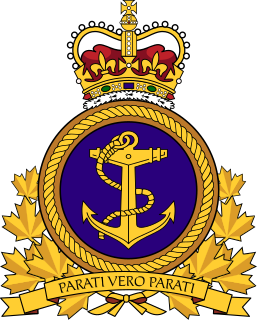
The Royal Canadian Navy is the naval force of Canada. The RCN is one of three environmental commands within the Canadian Armed Forces. As of 2021[update], the RCN operates 12 frigates, four attack submarines, 12 coastal defence vessels, eight patrol class training vessels, one offshore patrol vessel, and several auxiliary vessels. The RCN consists of 8,300 Regular Force and 3,600 Primary Reserve sailors, supported by 3,800 civilians. Vice-Admiral Craig Baines is the current commander of the Royal Canadian Navy and chief of the Naval Staff.
Six ships of the Royal Navy have borne the name HMS Minotaur after the minotaur, a creature in Greek mythology:

The Royal Canadian Sea Cadets is a Canadian national youth program sponsored by the Canadian Armed Forces and the civilian Navy League of Canada. Administered by the Canadian Forces, the program is funded through the Department of National Defence, with the civilian partner providing support in the local community. Cadets are not members of the Canadian Armed Forces.
Eighteen ships of the Royal Navy have borne the name Hunter:
Five ships of the Royal Navy have borne the name HMS Kingston.

HMCS Shawinigan is a Kingston-class coastal defence vessel that has served in the Canadian Forces and the Royal Canadian Navy since 1997. Shawinigan is the fifth ship of her class. She is the second vessel to use the designation HMCS Shawinigan. The ship is assigned to Maritime Forces Atlantic (MARLANT) and is homeported at CFB Halifax.
Eleven ships of the Royal Navy have borne the name HMS Unicorn, after the mythological creature, the unicorn:

HMCS Ontario was a Minotaur-class light cruiser built for the Royal Navy as HMS Minotaur (53), but transferred to the Royal Canadian Navy on completion and renamed Ontario.
Several Canadian naval units have been named HMCS Quebec.
The Royal Naval College of Canada (RNCC) was established by the Department of the Naval Service after the formation of the Royal Canadian Navy (RCN) in 1910. The college was placed under the auspices of the Minister of Naval Service and controlled by the Director of the Naval Service, Rear-Admiral Charles Kingsmill. The initial goal was to train a new generation of Canadian naval officers for the RCN. The college existed from 1911 to 1922 and educated about 150 students until it was closed due to declining numbers and budget cuts by the government of Canada. As the RCN did not have large ships of its own other than HMCS Niobe and HMCS Rainbow, the cadets followed a course of study that would qualify them for eventual service on British warships. The graduated midshipmen were required to serve approximately one year of "big ship duty" as part of their training.
Two ships of the Royal Navy have borne the name HMS Windsor, after the English town of Windsor, Berkshire:
Two ships of the Royal Navy have borne the name HMS St John:
HMS Ontario can refer to several ships:
Halifax commonly refers to:
Twenty-two ships of the Royal Navy have borne the name HMS Fortune:
Captain John Moreau Grant CBE (1895–1986) was the first Commanding Officer of HMCS Royal Roads in Esquimalt, British Columbia. The Grant Building at Royal Roads University was named in his honour.
Commodore William "Willy" Prine Hayes CD, ADC was a Canadian Commodore and educator. He served as the Commandant at Royal Military College of Canada from 1967 to 1969. He served as the Commandant at the Royal Roads Military College.

Vice-Admiral Harold Taylor Wood Grant was a Canadian naval officer and a post-war Chief of the Naval Staff. The son of Lieutenant Governor of Nova Scotia, MacCallum Grant, Harold Grant entered the Royal Canadian Navy as a cadet in 1914. He spent most of the First World War in training until 1917, when he became a midshipman aboard a British Royal Navy ship. Considered an above average officer, he was earmarked for early promotion during the interwar period and by 1938, commanded the destroyer HMCS Skeena.

HMCS Trentonian was a modified Flower-class corvette that served with the Royal Canadian Navy during the Second World War. She fought primarily in the Battle of the Atlantic and the English Channel as a convoy escort. She was named for Trenton, Ontario, though due to a naming conflict with another vessel, her name was changed. She was sunk in 1945.






